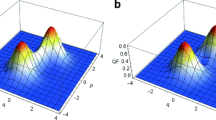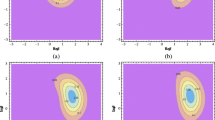Abstract
We investigate the observable non-classical features of the photon-added compass state (PACS) by its sub-Poissonian statistics, such as the Mandel’s parameter, second-order correlation function, photon-number distribution and the quasi-probability distribution functions, peculiarly the negativity in the Wigner distribution of the PACS as the specific non-classical features. We study the squeezing properties of the PACS and find the PACS does not show squeezing properties of the quadrature. Finally, we give the non-Gaussianity of the PACS by the fidelity between the PACS and the squeezed coherent state (SCS).








Similar content being viewed by others
References
Kok, P.: Nat. Photonics 4, 504 (2010)
Braunstein, S.L., Loock, P.: Rev. Mod. Phys. 77, 513 (2005)
Zeilinger, A.: Rev. Mod. Phys. 71, S288 (1999)
Bouwmeester, D., Ekert, A., Zeilinger, A.: The Physics of Quantum Information. Springer, Berlin (2000)
Kim, M.S.: J. Phys. B 41, 133001 (2008)
Bartlett, S.D., Sanders, B.C.: Phys. Rev. A 65, 042304 (2002)
Agarwal, G.S., Tara, K.: Phys. Rev. A 43, 492 (1991)
Zavatta, A., Viciani, S., Bellini, M.: Science 306, 660 (2004)
Zavatta, A., ParigiV, K.M.S., Jeong, H., Bellini, M.: Phys. Rev. Lett. 103, 140406 (2009)
Lee, S.-Y., Nha, H.: Phys. Rev. A 82, 053812 (2010)
Hu, L.Y., Xu, X.X., Wang, Z.S., Xu, X.F.: Phys. Rev. A 82, 043842 (2010)
Wang, Z., Meng, X.G., Fan, H.Y.: J. Phys. A, Math. Theor. 46, 135305 (2013)
Hu, L.Y., Fan, H.Y.: J. Opt. Soc. Am. B 25, 1955 (2008)
Hu, L.Y., Xu, X.X., Fan, H.Y.: J. Opt. Soc. Am. B 27, 286 (2010)
Hu, L.Y., Zhang, Z.M.: J. Opt. Soc. Am. B 30, 518 (2013)
Ren, G., Du, J.M., Yu, H.J., Xu, Y.J.: J. Opt. Soc. Am. B 29, 3412 (2012)
Schröinger, E.: Naturwissenschaften 23, 807 (1935)
Wolf, D.Ed.: Progress in Optics vol. XXXIV. North-Holland, Amsterdam (1995)
Dodonov, V.V.: J. Opt. B 4, R1 (2002)
Stobińska, M., Jeong, H., Ralph, T.C.: Phys. Rev. A 75, 052105 (2007)
Jeong, H., Son, W., Kim, M.S., Ahn, D., Brukner, C.: Phys. Rev. A 67, 012106 (2003)
Lund, A.P., Jeong, H., Ralph, T.C., Kim, M.S.: Phys. Rev. A 70, 020101(R) (2004)
Jeong, H., Kim, M.S., Ralph, T.C., Ham, B.S.: Phys. Rev. A 70, 061801(R) (2004)
Wakui, K., Takahashi, H., Furusawa, A., Sasaki, M.: Opt. Express 15, 3568 (2007)
Jeong, H.: Phys. Rev. A 72, 034305 (2005)
Ourjoumtsev, A., Jeong, H., Tualle-Brouri, R., Grangier, Ph.: Nature 448, 784 (2007)
Agarwal, G.S., Pathak, P.K.: Phys. Rev. A 70, 053813 (2004)
Fan, H.Y., Lu, H.L., Fan, Y.: Ann. Phys. 321, 480 (2006)
Puri, R.R.: Mathematical Methods of Quantum Optics. Springer, Berlin (2001)
Mandel, L.: Opt. Lett. 4, 205 (1979)
Mandel, L.: Phys. Rev. Lett. 49, 136 (1982)
Lambropoulos, P., Petrosyan, D.: Fundamentals of Quantum Optics and Quantum Information. Springer, Berlin (2007)
Mehta, C.L., Sudarshan, E.C.G.: Phys. Rev. 138, B274 (1965)
Scully, M.O., Zubairy, M.S.: Quantum Optics. Cambridge University Press, Cambridge (1997)
Moya-Cessa, H., Knight, P.L.: Phys. Rev. A 48, 2479 (1993)
Lee, S.Y., Ji, S.W., Kim, H.J., Nha, H.: Phys. Rev. A 84, 012302 (2011)
You, W.L., Li, Y.W., Gu, S.J.: Phys. Rev. E 76, 022101 (2007)
Fan, H.Y.: Phys. Rev. A 45, 6928 (1992)
Acknowledgements
This work is supported by the Natural Science Foundation of the Anhui Higher Education Institutions of China (Grant Nos. KJ2011Z339 and KJ2011Z359).
Author information
Authors and Affiliations
Corresponding author
Appendices
Appendix A: Derivation of Eq. (28)
In order to get Eq. (28), we first derive an integral formula
where we have used
whose convergent condition is \(\operatorname{Re} ( \xi+f+g ) <0,\ \operatorname{Re} ( \frac{\zeta^{2}-4fg}{\xi+f+g} ) <0\), or \(\operatorname{Re} ( \xi-f-g ) <0\), \(\operatorname{Re} ( \frac{\zeta^{2}-4fg}{\xi-f-g} ) <0\).
Using Eqs. (25) and (A.1), we obtain
where
and
Substituting Eqs. (A.4)–(A.7) into Eq. (A.3) and after some steps to simplify the equation, we derive the result in Eq. (28) as expected.
Appendix B: Derivation of Eq. (40)
Using Eq. (A.2), we have
where in the last step we have used the general generating function of single variable Hermite polynomials
According to Eqs. (39) and (B.2), we have
where
and
Using Eqs. (B.1) and (B.4)–(B.7), we have
Rights and permissions
About this article
Cite this article
Ren, G., ma, Jg., Du, Jm. et al. Non-classical Properties of Photon-Added Compass State. Int J Theor Phys 53, 856–869 (2014). https://doi.org/10.1007/s10773-013-1874-y
Received:
Accepted:
Published:
Issue Date:
DOI: https://doi.org/10.1007/s10773-013-1874-y




